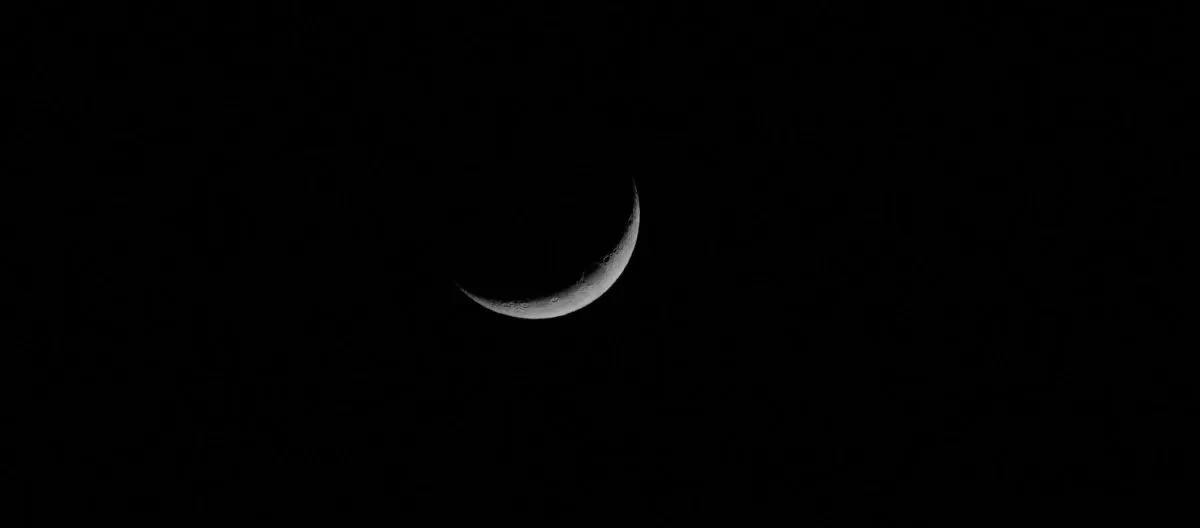While a new Moon may seem to bring fewer opportunities for night sky watching, without any lunar glow it will be easier to spot the Lyrids meteor shower tonight.
The new Moon also plays a significant cultural role including, for many people, symbolising rebirth and marking the end of Ramadan: the month of daytime fasting in the Islamic calendar.
In some parts of the world, this new Moon will be seen as part of a rare hybrid solar eclipse – but for most the sky tonight will be the darkest it gets during the lunar cycle. Learn more about why it is called a ‘hybrid’ solar eclipse – and if you'd like to learn more about searching the skies at night, check out our astronomy for beginners guide.
When is April's new Moon?
On 20 April, the new Moon will rise at 6:04am and set at 20:47pm (BST). As sunrise is at 5:55am and sunset is 20:05pm that day, most visibility of the new Moon will be lost in the Sun’s solar glare.
Even in that short period after sunset before the new Moon sets, it is unlikely you will be able to see it as the sky will still be bright.
What is a new Moon?
A new Moon is the stage of the lunar cycle when the Moon appears completely dark from our vantage point here on Earth.
We see (or don’t see) a new Moon when the side facing away from us is being illuminated by the Sun. At the opposite end of the lunar cycle, a full Moon lights up night-time scenes because we are seeing the Sun illuminate it directly.
During a new Moon, the Sun and Earth are on opposite sides of the Moon with its ‘dark side’ facing Earth. This alignment is called a conjunction or syzygy. During a full Moon, it is Earth that is in the middle.
A new Moon typically occurs every 29.53 days, meaning that 'once in a Blue Moon' there are two in a month. While a ‘Blue Moon’ refers to the rare occasions when there are two full Moons in a month, a ‘Black Moon’ is when there are two new Moons.

Can you see a new Moon with the naked eye?
A new Moon generally can’t be seen by the naked eye as the sun is not shining on the side that we can see. In the coming days, keep an eye out for the very slim crescent Moon that follows.
When there is a solar eclipse, you'll have a much better chance of glimpsing a new Moon. In fact, because new Moons occur when the Moon is sitting directly between Earth and the Sun, solar eclipses can only happen during a new Moon.
A phenomenon called ‘earthshine’ can also show us the full Moon when it’s not actually a true full Moon. Sunlight reflects off Earth’s surface, illuminates the ‘dark side’ (or night side) of the Moon, and is reflected back to us.
What constellation will this April new Moon be in?
On 20 April, the April new Moon will be in the constellation of Pisces but moving towards Aries and Cetus. It will be closely following the Sun, and both will be in the vicinity of Jupiter.
Why is this Moon significant in Islam?
The Islamic festival of Eid al-Fitr that follows the end of Ramadan begins with the sighting of the first sliver of the crescent Moon (or hilal) after this new Moon. The Islamic ‘new Moon’ refers to this first crescent Moon, rather than the astronomical new Moon when there is no glow at all.
The lunar calendar therefore dictates the date of Eid – which is often why the date of the festival is only confirmed the night before. While the appearance of a crescent Moon can be predicted ahead of time, it might be blocked by clouds or obscured by a bright sky on the night.
Read more: